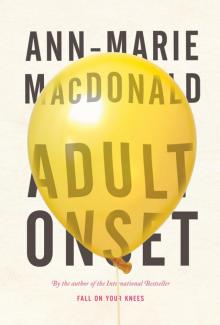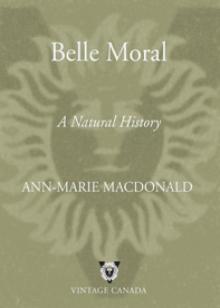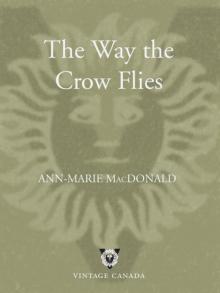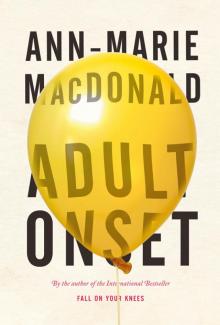- Home
- Ann-Marie MacDonald
Belle Moral: A Natural History Page 9
Belle Moral: A Natural History Read online
Page 9
PEARL. “Knowledge is power” said Francis Bacon. I too am a child of the Enlightenment.
DR REID. I fear you are its bastard.
PEARL. Was it rational to deprive me of the crucial fact?
DR REID. A fact that would have destroyed your objectivity.
PEARL. What is objectivity but the ability to consider every influence on our powers of observation? Facts, uprooted, can tell us only so much. A fact out of context is like a fish on a slab, inexplicable without water.
VICTOR. Like an ear in a jar, inexplicable without a head.
PEARL. Facts do not float in sterile solitude, they are embedded in reality, tainted with everyday life, stained with history; inextricable, like Darwin’s web. How am I to know Claire and other marvels of nature as ordinary as a dust mote, if I do not admit to being part of that exquisitely, well-nigh infinitely, complex web? The remains of Julius Ceasar may be in that speck of dust. I shall be in that speck of dust one day. [ambushed emotionally] We are all here so briefly. Awake, for a moment. Unique, for a moment. Able to look and to love, for a moment. And then we return. To the generosity of this universe and its great making power. That is love. And nothing, not even the merest particle, reveals itself without it.
A beat.
ABBOTT. I have seen the face of God in a three hundred thousand year old trilobite.
A beat.
PEARL. Seamus, you look at us and see an incoherent jumble. I look and see affinities. Patterns.
VICTOR. A story.
PEARL. That’s right. A plot. You’re probably right, Seamus, we’re probably quite a bad idea, really. We don’t matter a great deal, we’re on the fringes; of empire, of science, art and culture. We cannot even claim the weight of oppression that might yield a diamond eons from now. But perhaps, simply by thinking our thoughts and living our lives with passionate curiosity and unreasonable kindness, we do our part in the slow universal accumulation of – of critical mass, to coin a phrase – that crystallizes in true discovery.
FLORA. Pearl, it’s nigh on four o’clock, your friends will be faimished, come Wee Farleigh and help me –
PEARL [going for her camera]. Don’t you dare move, either of you.
FLORA. Your sister’s faint with hunger, look at her.
PEARL. Of course she’s half-starved, Victor’s turned her into a vegetarian.
VICTOR. How can you talk of kindness, Pearl, and still eat other animals?
PEARL. Don’t start, Victor.
VICTOR. You started it.
PEARL. I didna –! VICTOR. Did –!
FLORA. I’ve a lovely leg of lamb, you’re all to stay; and for the vegetablists, we’ve a … what’s it called, Wee Farleigh?
WEE FARLEIGH. A medley of beans. Baked savoury squash. A casserole of wild champignons and nuts. A milles-feuilles of goat cheese, grilled aubergine, slow-roasted tomato mousse and toasted garlic on a bed of kelp. And for dessert: chocolate éclaires.
PEARL. The éclaires are for everyone, surely.
VICTOR. No, you get a black-pudding for dessert.
PEARL. Seamus, will you stay to tea?
A beat.
DR REID. You are stubborn, clannish and benighted. An apple falls from a tree and you do not shout, “Eureka!”, you eat the apple. You have no real conscience, only sentiment: you’d save the one to the detriment of the many, and call it “kindness”. You lack the mental rigour for true kindness. You shrink from inconvenient facts, preferring a retreat to your hot-house of exotic half-truths; your ramshackle relativism; your primordial swamp; your bog, your blur. You haven’t the strength to withstand the whirlwind, or the unflinching gaze required to see into it. One look at the face of God and you would be annihilated. It is dearly to be hoped that you occupy an evolutionary cul-de-sac. Otherwise, heaven help us all.
Exit, DR REID. PEARL unwinds a cord with a small plunger from the camera and runs it to where the company is assembled for the photo. She holds the plunger and assumes her position in the photo line-up.
PEARL. Ready? [About to press the plunger.] And –
CLAIRE. Ainaibh ri chelie.
YOUNG FARLEIGH wakes up.
PEARL. What does that mean?
YOUNG FARLEIGH. ’Tis Gaelic.
VICTOR. I know “ ’tis Gaelic” –
FLORA. It’s your mother’s clan motto –
CLAIRE. It means: “unite”.
PEARL presses the plunger and the camera responds with a poof and a flash. Curtain. PUPPY barks.
Afterword
by Ann-Marie MacDonald
Belle Moral: A Natural History has its origins in an earlier play of mine called The Arab’s Mouth, and the story of its evolution is also the story of a creative relationship. The Arab’s Mouth was first produced in 1990 by Toronto’s Factory Theatre and its then-artistic director, Jackie Maxwell. An interesting sidebar – and natural history is all about the sidebars – is that, at the time, I nurtured hopes that one day the play might be programmed by the Shaw Festival; this, owing to my passion for the period, as well as my enduring regard for the Festival itself, then under the direction of Christopher Newton. Alas, the mandate had yet to be expanded to include works such as mine that were set but not written during Shaw’s lifetime – just as well, for The Arab’s Mouth had some critical evolutionary transformations to undergo before it became Belle Moral.
After The Arab’s Mouth premiered, I knew that it was not quite finished and, in keeping with my experience as a playwright and collaborator, I fully expected to return to it. I got distracted, how ever, by another project which I thought would be a play but turned out to be a novel. Fall On Your Knees developed many of the themes and images that I had touched on in The Arab’s Mouth, and I came to see the play as a progenitor – or, to change metaphors, as a kind of sketch book for the novel. Years went by and I sought to lay to rest the little voice at the back of my mind insisting, “What about me?” The Arab’s Mouth had become a ghost that would not rest, and no amount of fiction, or indeed other theatre work, would quiet it. Thus, when Jackie Maxwell invited me to revisit the piece, I was completely delighted and my initial inner response was, “No.” Writing is hard. Rewriting is harder. And I was scared to look that deeply into my creative past, having never glanced at the script in all those intervening years. What would I find upon re-entering that abandoned house? Would the ghosts be angry? Spoiling for a fight? Or in the mood for a party? And what would my much younger self have to say to me now, an experienced writer striding in to turn it all upside down?
The first step was to read the play again after almost fourteen years. I did so, looking and listening for one thing – a heartbeat. There is a good reason why certain ghosts refuse to rest: they’re not dead. There was indeed a heartbeat. A strong one. I was put in mind of a young race horse, all bony, and pounding with vitality, panting with the passion to run, bursting from the starting gate in all directions at once. It was all over the map, but it was alive.
I did much more work on the script than I, or I think Jackie, expected. Characters and elements of plot that I had once thought of as structurally and thematically integral went the way of the demolition crew without a tremor, clearing the way for new characters as well as new – if certainly fewer – story elements. A great deal had happened in the world and in my life as an artist since 1990, and my world-view had grown. Whereas The Arab’s Mouth was an almost truculent assertion of the primacy of the irrational and the relativistic, Belle Moral reaches out in two directions to reconcile the extremes of rationalism and romanticism, in an attempt to re-envision and to articulate afresh those core Enlightenment values that engendered the freedom and equality that we take for granted at our peril. Today, the forces of fundamentalism threaten to undo that civilized and precious mess we call democracy, substituting simple answers and ruthless solutions in the place of plurality and debate, promoting superstition and prejudice over curiosity and courage. The Scopes Trial is being replayed in North American schools even as real-li
fe chimeras are being created in labs – and moral vacuums – around the world; this mixture of backward thinking and highly sophisticated technology is potentially explosive.
But I’m essentially a comedian. Which is to say, an informed, jaded, jaundiced, optimist. There may be unhappy endings to stories, but all stories are happy, because as long as there are stories, there is hope. If even one person – or indeed, creature – is able to emerge from the rubble of our own making to say, “I remember what happened. Listen, and I’ll tell you,” that’s a happy ending. Bearing witness can be just that: the carrying of a heavy load that eventually must be shared. As long as there is one ancient, flea-bitten, parched and starving mariner able to stagger up to a wedding party and tell his or her tale, there is compassion – that insight which makes the tale intelligible and is the progenitor of imagination. And imagination in turn, if it is not Dr Frankenstein’s longed-for spark of life itself, is certainly the spark of civilization.
A Note for Practitioners
Belle Moral: A Natural History is a dark but redemptive comedy. At a narrative level, it is a story of family secrets come to light. It is also the story of the birth and evolution of ideas, and of ways of seeing, and living in, the world. As such, it is truly a play of morals. Stylistically there is fun to be had with its Gothic references, but the tone ought never to stray into pastiche or melodrama. That said, the stakes are high and, even in calmer moments, a sense of urgency is never far below the surface. These characters think quickly and speak articulately. They formulate their thoughts in the moment, and they enjoy argument.
Victor’s lust for life extends to a revelling in his own “romantic martyrdom” – even when he is pouting, he does so with enthusiasm and is never depressive. His geniality, mischievous sarcasm and hell-bent good humour all serve to buoy him up over a well of grief. When that grief splashes up in the first act, and then when it boils over at the end of the second act, it is sudden, genuine and passionate.
Pearl protects herself emotionally with her arch tone and severe attitude toward Victor in particular and weakness in general, but beneath her controlled exterior is a deep love for her brother and unresolved grief at the loss of her mother and the remoteness of her father. If Victor is given to sudden swings between laughter and tears, Pearl switches just as rapidly between “cool” rationalism and white-hot rage.
Dr Reid is a reasonable man who embodies much of what was considered humane and progressive at the time. Indeed, some of his more odious views are still culturally dominant in ways that we might be reluctant to admit, while others are genuinely sound both morally and intellectually. His is the story of a man who is seduced by a second chance; of good intentions gone awry; of the subtle, and crucial, relationship between knowledge and power; and of the very different meanings – or species – of love. Dr Reid is the hero of his own story, a good and ethical man to the end, in his own eyes.
Flora is deceptively dotty on the surface, and fearless at the core. Her “dottiness” is an effect of her good-natured impulse to nurture her loved-ones, combined with her effort to keep track of all the lies and secrets in the family. With her hybrid belief system she is actually more open-minded than many other more sophisticated souls. One imagines her and Einstein chatting together quite happily. She is motivated by love for her family, but that love is tainted by a guilt that serves to distort her judgment until the final act.
Scene changes are, among other things, an opportunity for the Underworld to assert its presence in the person of the Anubis figure. In the first scene he claims the Bride for the Underworld, and by the third act he is waiting patiently for the chance to claim the Creature/Claire. It should be noted that the Bride is a ghostly evocation of Régine who has been searching the Underworld for her lost child, while hoping not to find her there.
Puppy, in the original production, was “played” by a puppet, specially constructed from a taxidermy mould, painted, and finished with fur. The head and tail detached, and he was operated by the actor playing The Bride/Creature/Claire, in a puppetry style reminiscent of that used in Japanese theatre.
By the end of the play, the world has changed. Gothic shadows have given way to the light of day, corsets disappear, and conformity is knocked aside by a deadly serious playfulness. For a moment, the horizon is unclouded. It is only a matter of time, however, before Dr Reid, and his quest for Utopia, will give rise to the cataclysms of the twentieth century. But for one brief, shining, “belle époque” moment, there is peace, and space for the imagination to run free. —A.M.

 Adult Onset
Adult Onset Belle Moral: A Natural History
Belle Moral: A Natural History The Way the Crow Flies
The Way the Crow Flies SSC (2012) Adult Onset
SSC (2012) Adult Onset